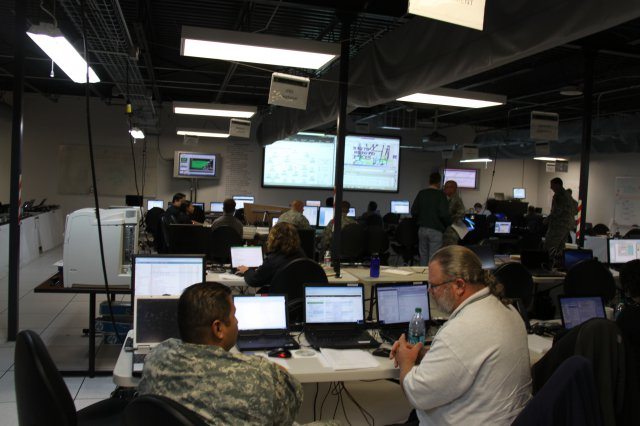As it makes major upgrades to its tactical communications network, the Army is also revamping the way Soldiers can monitor and manage network performance in real time.
Today, each component of the network — such as a certain type of radio or satellite system — is managed separately with its own software, hardware and human resources. But as the Army steps closer to fielding integrated sets of network capabilities to full brigade combat teams, the service is now aiming to manage the network holistically.
“Just as we will field the tactical network as an integrated capability, we must manage it as an integrated system within the brigade combat team,” said Col. Dan Hughes, the Army’s system of systems integration director. “NETOPS will enable us to view the holistic integrated network baseline, so if the need to apply fixes in the field does occur, we can respond knowing how a specific fix may affect other network capability within the brigade. This integrated approach is new, so we are using the Network Integration Evaluation (NIE) process to help hammer out technical and doctrinal issues as they arise.”
Through the twice-annual NIE field exercises, the Army has brought dozens of different network management tools it currently fields together in a realistic operational setting. This management includes monitoring how quickly and completely information is traveling over the network, allocating bandwidth and other resources to match operational needs, troubleshooting various system issues and other aspects essential to establishing and maintaining communications.
During the recently concluded NIE 12.1, Soldiers from the 2nd Brigade, 1st Armored Division and Army system engineers made progress toward integrating and streamlining network management capabilities into common standards. The idea is to shift from multiple tools, each displaying data on a certain piece of the network, to a broad network operations framework that will aggregate that data into actionable information for the commander.
“For the first time we’ve got exposure on exactly how these tools do business and how we need to do business in order to get that visibility across the board,” said Clifton Basnight, director of the Network Integration Service Center, which manages NETOPS at the NIEs. “We’re trying to find ways of converging these tools so that we can provide not just data to a commander, but intelligence.”
Acting as the “nerve center” for the massive exercise, the Network Integration Service Center, or NISC, houses experts in different aspects of the network, such as spectrum operations or cyber defense. Together, they oversee and troubleshoot the systems involved in the NIE, ranging from radios to software applications to satellites. They also document achievements, such as transmitting troop locations and video clips from handheld devices carried by Soldiers on the front lines all the way up to a command post.
“Through empirical data and Soldier feedback that we’re getting out in the field, we can judge how well this network is being integrated and how the capabilities are coming together,” Basnight said.
The NIEs are a series of field exercises involving 3,800 Soldiers of the 2nd Brigade, 1st Armored Division, designed to rapidly integrate and mature the Army’s tactical network. Soldier feedback and test results from the NIEs are directly shaping the makeup of the Army’s network Capability Set 13, which will begin fielding in fiscal year 2013 to up to eight brigade combat teams.
Additional brigades will receive the latest network assets as part of Capability Set 14. Those capability sets will include greater bandwidth to transmit voice, video and data across the battlefield, as well as the ability to bring situational awareness and mission command information down to the dismounted Soldier.
The capability set approach represents a strategic shift in how the Army buys, tests and delivers the tactical network. Rather than deploying individual devices with their own distinct requirements and acquisition timelines, the Army is integrating and deploying complete sets of networked capabilities, which are developed by both government and industry, as soon as they become mature and are proven operationally relevant to the Soldier.
“The goal of this whole NIE process is to get an integrated network baseline that we can adjust from,” Hughes said.
That vision requires common standards for network management, something the Army is pursuing through the NIEs. These standards will also support the Army’s goal of allowing industry to “plug and play” its latest technologies into the network to meet defined capability gaps.
One new network management capability that will be evaluated at the NIEs is the Warfighter Initialization Tool, known as WIT, developed by the Army’s Product Director Tactical Network Initialization. The WIT is a user-friendly tool designed to enhance the signal officer’s ability to configure and manage the unit task organization and network architecture for the commander. This collection of mission data, known as Data Products, is required to initialize networked systems, enabling end-to-end connectivity and interoperability across the tactical internet.
The WIT will enable signal officers to update their “digital phone book” to reflect what occurs in theater, such as equipment or organizational changes like receiving a new communications technology or temporarily cross-attaching another unit. Commanders will be able to take a more hands-on approach, defining and adapting their network based on their fight. The tool will also provide senior commanders with a more accurate Common Operational Picture, or COP, that provides a single display of relevant information to multiple commands.
“If I’m the one developing it, I’m the one saying, ‘I know where this truck belongs. I know what this truck has in it. I know what its function will be,’ so I can allocate resources more precisely,” said Chief Warrant Officer 2 Mark Smith, a 2/1 AD Soldier who trained on the WIT at NIE 12.1. “It’s going to be a phenomenal tool. It’s going to be what we need.”
The WIT will be integrated into NIE mission scenarios as a System Under Evaluation at NIE 12.2, the next event in the series that will take place in the spring of 2012.










